| San Quirico d'Orcia | |
|---|---|
| Comune | |
| Comune di San Quirico d'Orcia | |
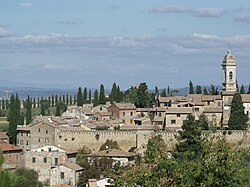 | |
 Coat of arms Coat of arms | |
 San Quirico within the Province of Siena San Quirico within the Province of Siena | |
| Location of San Quirico d'Orcia | |
  | |
| Coordinates: 43°4′N 11°36′E / 43.067°N 11.600°E / 43.067; 11.600 | |
| Country | Italy |
| Region | Tuscany |
| Province | Siena (SI) |
| Frazioni | Bagno Vignoni, Fornace Laterizi |
| Government | |
| • Mayor | Danilo Maramai (Centre-left) |
| Area | |
| • Total | 42.12 km (16.26 sq mi) |
| Elevation | 409 m (1,342 ft) |
| Population | |
| • Total | 2,672 |
| • Density | 63/km (160/sq mi) |
| Demonym | Sanquirichesi |
| Time zone | UTC+1 (CET) |
| • Summer (DST) | UTC+2 (CEST) |
| Postal code | 53027 |
| Dialing code | 0577 |
| Website | Official website |
San Quirico d'Orcia is a comune (municipality) of about 2,500 inhabitants in the Province of Siena in the Italian region Tuscany, located about 80 kilometres (50 mi) southeast of Florence and about 35 kilometres (22 mi) southeast of Siena inside the Valdorcia landscape. It is named in honor of Saint Quiricus.
Located on the Via Francigena, San Quirico d'Orcia borders the municipalities of Castiglione d'Orcia, Montalcino and Pienza.
 A panoramic view of San Quirico d'Orcia from the south
A panoramic view of San Quirico d'Orcia from the south
Main sights
The frazione of Vignoni houses a castle, a residence of the Salimbeni family in the 12th century. It includes a top-less tower and a Romanesque church, once housing a crufix by Giambologna, now in the Museum of Montalcino. Annexed is also the (rebuilt) 15th century Palazzo degli Amerighi, where a plot was set against the Spanish who menaced Siena in 1558–59.
San Quirico is home to the following churches:
- Collegiate church of San Quirico. Once a rural pieve (pleban church) from the 8th century, with a baptismal font, it was rebuilt into the current structure in the 12th century. The rear section was altered in 1663 to add the choir. It is on the Latin cross plan, with a single nave and side chapels. Notable is the main portal, in Lombard style, consisting in a decorated protiro in sandstone, with columns supported by lions. The arch includes ten columns, whose capitals are decorated with animals and vegetable figures, while the architrave features two crocodiles facing each other. The lunette has a high-relief sculpture allegedly portraying St. Damasus, though likely to be identified with St. Quiricus. A side portal, added in the 13th century, has been attributed to Giovanni Pisano, who was in Siena at the time. Most of the interior decoration date to the 17th century, while the bell tower was rebuilt in 1798–1806.
- Romanesque church of San Biagio a Vignoni
- Church of Santa Maria Assunta (late 11th century)
- Church of Madonna di Vitaleta, housing a "Madonna" attributed to Andrea della Robbia
- Church of San Giovanni Battista, at Bagno Vignoni
- Horti Leonini (1561), an example of Italian garden
-
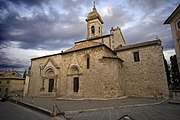 Collegiate church of San Quirico
Collegiate church of San Quirico
-
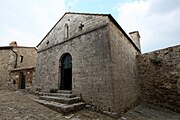 Church of San Biagio
Church of San Biagio
-
 Church of Santa Maria Assunta
Church of Santa Maria Assunta
-
 Facade of Oratorio della Misericordia
Facade of Oratorio della Misericordia
-
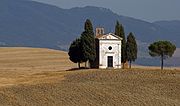 Chapel of Madonna di Vitaleta
Chapel of Madonna di Vitaleta
-
 Church of Madonna di Vitaleta
Church of Madonna di Vitaleta
-
 Church of San Giovanni Battista
Church of San Giovanni Battista
-
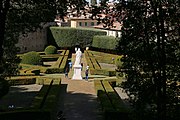 Horti Leonini
Horti Leonini
References
- "Superficie di Comuni Province e Regioni italiane al 9 ottobre 2011". Italian National Institute of Statistics. Retrieved 16 March 2019.
- All demographics and other statistics: Italian statistical institute Istat.
External links
- (in Italian) Official website
- (in Italian) Collegiate Church of Saints Quirico and Giulitta, San Quirico d'Orcia
This Province of Siena location article is a stub. You can help Misplaced Pages by expanding it. |
